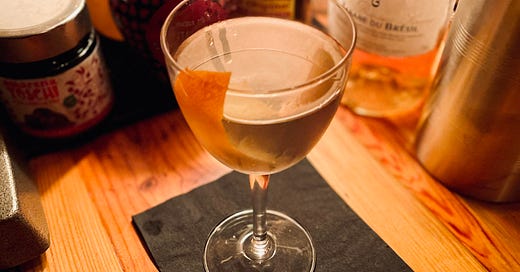The Banana Martini and a General Theory of Fruit Liqueurs
Sweet, fruity, and interchangeable.
I have probably pushed more banana cocktails on you than you were expecting. Honestly, I’ve probably written about banana cocktails than I was expecting. This is, after all, not Banana Cocktails With Suderman. But good banana liqueur is delicious, and it works surprisingly well in any number of formats and flavor combinations.
I’m not the only one who likes it, either. It’s also a surprisingly common ingredient in many modern cocktails. Banana liqueur is all over the most recent Death & Co. book, Welcome Home. You can find it in weird drinks from the Dead Rabbit. And on my recent trip to the The Fox Bar & Cocktail Club in Nashville, I tried a stirred-and-boozy bourbon-vermouth-chocolate-banana cocktail, which was phenomenal.
Banana cocktails. They’re everywhere. You can’t escape.
(Okay, fine you could probably escape. But why would you want to?)
The thing is, deliciously complex but slightly gimmicky banana cocktails are just the beginning. That’s because you can transfer much of your banana liqueur-cocktail knowledge onto the use of other high-quality fruit liqueurs. Those unique fruit liqueurs aren’t essential for every home bar cart. You certainly don’t need a whole shelf of them, as I have somehow now have.
But they feature prominently in many high-end modern cocktails, and if you understand how they function inside drinks — if you get the role they play — then you can use them to substitute, modify, and adapt accordingly, even if banana cocktails aren’t really your thing.
So today, we’re going to make a Banana Martini, which, with small adjustments and substitutions, can also be transformed into a Grapefruit Martini, a Pineapple Martini, a Passionfruit Martini, or even a Lychee Martini — and possibly quite a few other versions I haven’t tried or thought of yet.
A Fruitin’ Tootin’ Good Time
Let’s start by defining the category.



